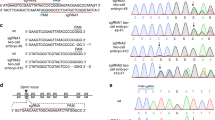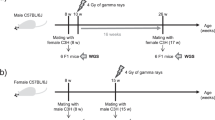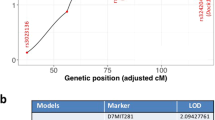Abstract
THE known lethal alleles at the albino locus of mice are radiation-induced and cause prenatal or early neonatal death. Four alleles expressed in the homozygous newborn as absence of pigment and early neonatal death (c14COS, c112K, c65K, and c3H) were found to cause hypoglycaemia and deficiency of glucose-6-phosphatase and other enzymes1–3. Two additional radiation-induced alleles (c6H and c25H) act as early embryonic lethals. Complementation tests between these lethal-albino alleles suggested that all six mutations could be deficiencies for genetic material other than just the albino locus1. Since X rays are known to produce small deletions4,5, all six of these mutations have been tested with various closely linked genes using the standard deletion mapping procedure. Unfortunately, the two most closely linked genes to c, taupe (tp) and shaker-1 (sh-1) (order with centi-Morgans (cM) distance, tp – 2 – c – 4 – sh-1), seemed not to have been deleted in any of the six lethal-albino mutations2,6. Recently, the gene mitochondrial malic enzyme (Mod-2) that codes for electrophoretic variants of mitochondrial malic enzyme (MOD-2: EC 1.1.1.40, L-malate: NADP oxidoreductase, de-carboyxlating) was shown to reside in chromosome 7 one cM from c between c and sh-1 (ref. 7 and E. M. E. and D. L. Coleman, in preparation). We present evidence here showing that two of these mutations (c6H and c25H), but not the C14cos mutation, are deletions that extend into the Mod-2 locus.
This is a preview of subscription content, access via your institution
Access options
Subscribe to this journal
Receive 51 print issues and online access
$199.00 per year
only $3.90 per issue
Buy this article
- Purchase on Springer Link
- Instant access to full article PDF
Prices may be subject to local taxes which are calculated during checkout
Similar content being viewed by others
References
Erickson, R. P., Gluecksohn-Waelsch, S., and Cori, C. F., Proc. natn. Acad. Sci. U.S.A., 59, 437 (1968).
Gluecksohn-Waelsch, S., and Cori, C. F., Biochem, Genet., 4, 195 (1970).
Thorndike, J., Trigg, M. J., Stockert, R., Gluecksohn-Waelsch, S., and Cori, C. F., Biochem. Genet., 9, 25 (1973).
Wolff, S., A. Rev. Genet., 1, 221 (1967).
Russel, L. B., Mutation Res., 11, >107 (1971).
Eicher, E. M., Adv. Genet., 15, 175 (1971).
Eicher, E. M., and Southard, J. S., Mouse News Letter, 47, 37 (1972).
Shows, T. B., Chapman, V. M., and Ruddle, F. H., Biochem. Genet., 4, 707 (1970).
Gluecksohn-Waelsch, S., Schiffman, M. B., Thorndike, J., and Cori, C. F., Proc. natn. Acad. Sci. USA (in the press).
Author information
Authors and Affiliations
Rights and permissions
About this article
Cite this article
ERICKSON, R., EICHER, E. & GLUECKSOHN-WAELSCH, S. Demonstration in mouse of X-ray induced deletions for a known enzyme structural locus. Nature 248, 416–418 (1974). https://doi.org/10.1038/248416a0
Received:
Issue Date:
DOI: https://doi.org/10.1038/248416a0
This article is cited by
-
Mouse Chromosome 7
Mammalian Genome (1992)
-
Mouse chromosome 7
Mammalian Genome (1991)
-
Effect of gene dosage on expression of mitochondrial malic enzyme activity in the mouse
Nature (1978)
-
Cytological observations of deletions in pachytene stages of oogenesis and spermatogenesis in the mouse
Chromosoma (1976)
-
Gene dosage in a deletion for a nuclear-coded, mitochondrial enzyme
Nature (1974)
Comments
By submitting a comment you agree to abide by our Terms and Community Guidelines. If you find something abusive or that does not comply with our terms or guidelines please flag it as inappropriate.



